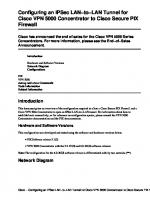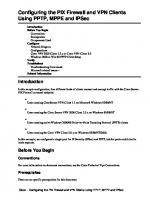HTTP and FTP Proxy-caching Using a Cisco Cache Engine 550 and a PIX Firewall
342 64 51KB
English Pages 10
Table of Contents......Page 2
Components Used......Page 3
Network Diagram......Page 4
Configurations......Page 5
2600 Router......Page 8
2600 Router......Page 9
Related Information......Page 10
Recommend Papers

- Similar Topics
- Computers
- Networking
File loading please wait...
Citation preview
TP and FTP Proxy−caching Using a Cisco Cache Engine 550 an
Cisco − HTTP and FTP Proxy−caching Using a Cisco Cache Engine 550 and a PIX Firewall
Table of Contents HTTP and FTP Proxy−caching Using a Cisco Cache Engine 550 and a PIX Firewall................................1 Introduction.............................................................................................................................................1 Before You Begin...................................................................................................................................1 Conventions...............................................................................................................................1 Prerequisites...............................................................................................................................1 Components Used......................................................................................................................1 Background Theory...................................................................................................................2 Configure................................................................................................................................................2 Network Diagram......................................................................................................................2 Configurations...........................................................................................................................3 Verify......................................................................................................................................................6 2600 Router................................................................................................................................6 Troubleshoot...........................................................................................................................................7 2600 Router................................................................................................................................7 Related Information................................................................................................................................8
i
HTTP and FTP Proxy−caching Using a Cisco Cache Engine 550 and a PIX Firewall Introduction Before You Begin Conventions Prerequisites Components Used Background Theory Configure Network Diagram Configurations Verify 2600 Router Troubleshoot 2600 Router Related Information
Introduction This tech note shows you how to set up a Cisco Cache Engine 550 to perform Hypertext Transfer Protocol (HTTP) / File Transfer Protocol (FTP) caching for Multipurpose Internet Mail Extensions (MIME) file types (RFC 2046) and for FTP directory listings.
Before You Begin Conventions For more information on document conventions, see the Cisco Technical Tips Conventions.
Prerequisites There are no specific prerequisites for this document.
Components Used The information in this document is based on the software and hardware versions below. • Cisco Cache Engine 550 running Cisco Cache Software Release 2.51 • Cisco 2600 Router running Cisco IOS® Software Release 12.2 • Cisco PIX Firewall running Secure PIX Firewall Software Release 6.0(1) • Web server running Internet Information Server 4.0 on Windows NT 4.0 SP6a Cisco − HTTP and FTP Proxy−caching Using a Cisco Cache Engine 550 and a PIX Firewall
The inside clients need to explicitly configure their browsers to use a manual HTTP/FTP proxy to the IP address of the Cache Engine on a specified port. The information presented in this document was created from devices in a specific lab environment. All of the devices used in this document started with a cleared (default) configuration. If you are working in a live network, ensure that you understand the potential impact of any command before using it.
Background Theory Inside clients need to explicitly configure their browsers to use a manual HTTP/FTP proxy to the IP address of the Cache Engine on a specified port. Specifically, the Cache Engine handles ftp:// style FTP requests over HTTP transport in proxy mode in passive and active mode and in an anonymous and authenticated mode (RFC 1738). The Private Internet Exchange (PIX) firewall in front of the Cache Engine allows HTTP/FTP traffic coming only from the single IP address of the Cache Engine. This means that clients cannot HTTP/FTP directly to the outside. Because all requests come from just one IP address, the Cache Engine enforces the security policy of who and who is not allowed to HTTP/FTP outside.
Configure In this section, you are presented with the information to configure the features described in this document. Note: To find additional information on the commands used in this document, use the IOS Command Lookup tool.
Network Diagram This document uses the network setup shown in the diagram below.
Cisco − HTTP and FTP Proxy−caching Using a Cisco Cache Engine 550 and a PIX Firewall
Configurations This document uses the configurations shown below. Cache Engine 550 Running Cisco Cache Software Release 2.51 ! ! hostname tikka ! interface ethernet 0 ip address 10.10.10.50 255.255.255.0 ip broadcast−address 10.10.10.255 bandwidth 10 halfduplex exit ! interface ethernet 1 exit ! ip default−gateway 10.10.10.1 ip name−server 144.254.15.102 ip domain−name cisco.com ip route 0.0.0.0 0.0.0.0 10.10.10.1 inetd enable ftp 12 cron file /local/etc/crontab clock timezone CET −7 0 ! no bypass load enable http max−ttl hours text 4 binary 8 http proxy incoming 8080
Cisco − HTTP and FTP Proxy−caching Using a Cisco Cache Engine 550 and a PIX Firewall
! radius−server authtimeout 21 radius−server key **** authentication login local enable authentication configuration local enable rule no−cache url−regex .*cgi−bin.* rule no−cache url−regex .*aw−cgi.* ftp proxy anonymous−pswd **** ftp proxy incoming 8080 ! !
PIX Version 6.0(1) PIX Version 6.0(1) nameif ethernet0 outside security0 nameif ethernet1 inside security100 nameif ethernet2 intf2 security10 enable password 8Ry2YjIyt7RRXU24 encrypted passwd 2KFQnbNIdI.2KYOU encrypted hostname pix−cache fixup protocol ftp 21 fixup protocol http 80 fixup protocol h323 1720 fixup protocol rsh 514 fixup protocol smtp 25 fixup protocol sqlnet 1521 fixup protocol sip 5060 fixup protocol skinny 2000 names access−list restrict−access−out permit ip host 10.10.10.50 any access−list restrict−access−out deny ip any any !−−− This access−list is allowing any IP traffic for the CE (UDP DNS queries !−−− are also needed to go through the PIX). pager lines 24 logging on logging buffered debugging interface ethernet0 10baset interface ethernet1 10baset interface ethernet2 auto shutdown mtu outside 1500 mtu inside 1500 mtu intf2 1500 ip address outside 172.17.241.47 255.255.255.0 ip address inside 8.8.8.2 255.255.255.0 ip address intf2 127.0.0.1 255.255.255.255 ip audit info action alarm ip audit attack action alarm no failover failover timeout 0:00:00 failover poll 15 failover ip address outside 0.0.0.0 failover ip address inside 0.0.0.0 failover ip address intf2 0.0.0.0 pdm history enable arp timeout 14400 global (outside) 1 172.17.241.48 nat (inside) 1 0.0.0.0 0.0.0.0 0 0 !−−− The lines nat and global are meant for any other traffic that is not supposed to be !−−− proxied by the CE (mail for example), but you would need to explicitly define
Cisco − HTTP and FTP Proxy−caching Using a Cisco Cache Engine 550 and a PIX Firewall
!−−− an entry in the restrict−access−out ACL to permit these outbound connections. access−group restrict−access−out in interface inside static (inside, outside) 172.17.241.50 10.10.10.50 ! This static would be used to statically map the CE to a specific external address. route outside 0.0.0.0 0.0.0.0 172.17.241.1 1 route inside 10.10.10.0 255.255.255.0 8.8.8.1 1 timeout xlate 3:00:00 timeout conn 1:00:00 half−closed 0:10:00 udp 0:02:00 rpc 0:10:00 h323 0:05:00 sip 0:30:00 sip_media 0:02:00 timeout uauth 0:05:00 absolute aaa−server TACACS+ protocol tacacs+ AAA−server RADIUS protocol radius no snmp−server location no snmp−server contact snmp−server community public no snmp−server enable traps floodguard enable no sysopt route dnat telnet 10.10.10.0 255.255.255.0 inside telnet timeout 5 ssh timeout 5 terminal width 80 Cryptochecksum:7f08b39173bbe1302bd24273973c89de : end [OK]
2600 version 12.2 service timestamps debug uptime service timestamps log uptime no service password−encryption ! hostname suicide ! enable password ww ! username all ! ! ! ! ip subnet−zero no ip domain−lookup ! cns event−service server ! ! ! ! ! ! ! ! interface FastEthernet0/0 ip address 8.8.8.1 255.255.255.0 no ip route−cache no ip mroute−cache speed 10 half−duplex ! interface Serial0/0
Cisco − HTTP and FTP Proxy−caching Using a Cisco Cache Engine 550 and a PIX Firewall
no ip address shutdown no fair−queue ! interface FastEthernet0/1 ip address 10.10.10.1 255.255.255.0 no ip route−cache no ip mroute−cache speed 10 half−duplex ! interface Serial0/1 no ip address shutdown ! ip classless ip route 0.0.0.0 0.0.0.0 8.8.8.2 ip http server ! line con 0 exec−timeout 0 0 transport input none line aux 0 line vty 0 4 password ww login ! no scheduler allocate end
Verify This section provides information you can use to confirm your configuration is working properly. Certain show commands are supported by the Output Interpreter tool, which allows you to view an analysis of show command output.
2600 Router You do not need to configure the 2600 router for FTP proxy caching. In this example, the router only relays inbound/outbound packets. The following example shows how to set FTP proxy−caching to an external FTP server. With HTTP, the procedure is the same. The client configures the FTP proxy in the browser, pointing it to 10.10.10.50:8080. All traffic goes through the Cache Engine. In the PIX, configure a static (with no conduit) for the Cache Engine. Users cannot access FTP sites without using the Cache Engine as a proxy. The following partial configuration shows an example of how to do this. pix−cache# pix−cache# show xlate 1 in use, 1 most used Global 172.17.241.50 Local 10.10.10.50 static pix−cache# show conduit pix−cache# show outbound pix−cache#
To enforce a security policy and block specific clients to access FTP to the outside, use the rule block command. Cisco − HTTP and FTP Proxy−caching Using a Cisco Cache Engine 550 and a PIX Firewall
rule block src−ip 10.10.10.11 255.255.255.0
You can view the statistics of the traffic being cached (FTP hits) by using the show statistics ftp command in the Cache Engine. tikka#show statistics ftp FTP Statistics −−−−−−−−−−−−−− FTP requests Received = 27 FTP Hits Requests Number of hits = Bytes = FTP Misses
17 358209
Requests Number of misses = 10 Bytes = 547368 Requests sent to Outgoing Proxy = 0 Requests sent to origin ftp server = 10 FTP error count = 0
Percentage 63.0 % 39.6 %
Percentage 37.0 % 60.4 %
Troubleshoot This section provides information you can use to troubleshoot your configuration.
2600 Router The following logs came from the Cache Engine upon the request issued in the client browser. tikka#debug http header all tikka#debug ftp packets tikka# Http request headers received from client: GET ftp://172.17.241.216/sample.txt HTTP/1.0 Referer: ftp://172.17.241.216/ Proxy−Connection: Keep−Alive User−Agent: Mozilla/4.75 [en] (WinNT; U) Pragma: no−cache Host: 172.17.241.216 Accept: image/gif, image/x−xbitmap, image/jpeg, image/pjpeg, image/png, */* Accept−Encoding: gzip Accept−Language: en Accept−Charset: iso−8859−1,*,utf−8 Mon Jul 2 06:40:59 2001: GET ftp://172.17.241.216/sample.txt HTTP/1.0 Referer: ftp://172.17.241.216/ Proxy−Connection: Keep−Alive User−Agent: Mozilla/4.75 [en] (WinNT; U) Pragma: no−cache Host: 172.17.241.216 Accept: image/gif, image/x−xbitmap, image/jpeg, image/pjpeg, image/png, */* Accept−Encoding: gzip Accept−Language: en Accept−Charset: ISO−8859−1,*,utf−8 Send Cmd : USER anonymous Mon Jul 2 06:40:59 2001: Send Cmd : USER anonymous Send Cmd : PASS XXXX Mon Jul 2 06:40:59 2001: Send Cmd : PASS XXXX Send Cmd : CWD sample.txt
Cisco − HTTP and FTP Proxy−caching Using a Cisco Cache Engine 550 and a PIX Firewall
Mon Jul 2 06:40:59 2001: Send Cmd : CWD sample.txt Send Cmd : MDTM sample.txt Mon Jul 2 06:40:59 2001: Send Cmd : MDTM sample.txt get_reply_info(): Last Modified Time : 1942132164 Mon Jul 2 06:40:59 2001: get_reply_info(): Last Modified Time : 1942132164 Send Cmd : TYPE A Mon Jul 2 06:40:59 2001: Send Cmd : TYPE A Send Cmd : PASV Mon Jul 2 06:40:59 2001: Send Cmd : PASV Send Cmd : RETR sample.txt Mon Jul 2 06:40:59 2001: Send Cmd : RETR sample.txt Send Cmd : QUIT Mon Jul 2 06:41:00 2001: Send Cmd : QUIT
Related Information • Cisco CSS 11000 Series Product Support Page • Technical Support − Cisco Systems
All contents are Copyright © 1992−2002 Cisco Systems, Inc. All rights reserved. Important Notices and Privacy Statement.
Updated: Oct 30, 2002
Document ID: 12560
Cisco − HTTP and FTP Proxy−caching Using a Cisco Cache Engine 550 and a PIX Firewall





![Cisco ASA and PIX Firewall Handbook [1 ed.]
9781587051586, 1587051583](https://ebin.pub/img/200x200/cisco-asa-and-pix-firewall-handbook-1nbsped-9781587051586-1587051583.jpg)
![Cisco ASA, PIX, and FWSM Firewall Handbook [2nd ed]
1587054574, 978-1-58705-457-0](https://ebin.pub/img/200x200/cisco-asa-pix-and-fwsm-firewall-handbook-2nd-ed-1587054574-978-1-58705-457-0.jpg)

![CCSP Cisco secure PIX® firewall advanced exam certification guide [2 ed.]
9781587201233, 1587201232](https://ebin.pub/img/200x200/ccsp-cisco-secure-pix-firewall-advanced-exam-certification-guide-2nbsped-9781587201233-1587201232.jpg)
![Cisco Security Specialist's Guide to PIX Firewall [1 ed.]
9781931836630, 1-931836-63-9](https://ebin.pub/img/200x200/cisco-security-specialists-guide-to-pix-firewall-1nbsped-9781931836630-1-931836-63-9.jpg)